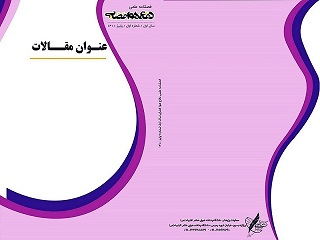نوع مقاله : مقاله پژوهشی
نویسندگان
1 استادیار، آزمایشگاه تحقیقاتی شیمی، دانشکده علوم پایه، دانشگاه آیت ا...بروجردی، کد پستی، 69737-69199 بروجرد، ایران
2 بخش شیمی دانشگاه پیام نور تهران ایران
چکیده
ابرخازنها به عنوان یک فناوری نوظهوردرذخیرهسازی انرژی در تجهیزات نظامی ، به دلیل چگالی توان بالا، عمر طولانی و سرعت شارژ-دشارژسریع، توجه زیادی را به خود جلب کردهاند. اجزای کلیدی این دستگاهها، مواد الکترودی است که به طور مستقیم بر ظرفیت ذخیرهسازی انرژی وکارایی آنها تأثیر میگذارد.به این منظور، مواد با چهارچوب فلز-آلی برپایه نیکل (Ni-MOF) با سطح ویژه بالا و تخلخل مناسب، سنتز شد. برای افزایش هدایت الکتریکی و خاصیت خازنی، چهارچوب فلز-آلی، مکسین تیتانیوم کربید (Ti3C2 MXene) وگرافن (Gr) افزوده شدند. ترکیب این مواد به روش هیدروترمال برسطح فوم نیکل (NF) نشانده شد. در این فرایند رشد نانو مواد MOF بین لایه ها، نه تنها با کاهش تجمع بین لایههای گرافن و مکسین، نقش مهمی در افزایش سطح در دسترس Ni-MOF/MXene/Gr/NF ایفا میکند، بلکه با تبدیل گرافن اکسید به گرافن، مسیرهای زیادی را برای انتقال الکترولیت فراهم میسازد. همچنین، استفاده از Ni-MOF باعث افزایش خاصیت شبهخازنی سیستم به دلیل الکتروفعال بودن نیکل میشود. ظرفیت ویژه الکترود Ni-MOF/MXene/Gr/NFبه عنوان آند درالکترولیتKOH 3 مولار، مقدار F g-1 845 و برای الکترود کاتد در قطب منفی (گرافن ایروژل (GA) ترکیب شده با کربن فعال C-GA/NF)، مقدار F.g-1 5/373 ثبت شد و برای ابرخازن نامتقارن Ni-MOF/MXene/Gr/NFllC-GA/NF ظرفیت ویژه Fg-1 637 درAg-1 1، انرژی ویژهW h kg-1 8/22 و توان ویژه kW kg-1 69/0 بدست آمد. و همچنین ظرفیت باقیمانده 2/55% ظرفیت اولیه بعد از طی5000 چرخه شارژ-دشارژ در چگالی جریان Ag-1 8 نشان دهنده پایداری و طول عمر چرخه ای بالای دستگاه مورد نظر می باشد.
کلیدواژهها
موضوعات
عنوان مقاله [English]
Fabrication of High-Performance Supercapacitor Based on Nickel Metal-Organic Framework /Titanium Carbide Mexen/Graphene Aerogel Nanocomposite for Use Military Devices
نویسندگان [English]
- Seyyed Mehdi Khoshfetrat 1
- Mansur Hadadi 2
- Mohammadreza Baezzat 2
1 Department of Chemistry, Faculty of Basic Sciences, Ayatollah Boroujerdi Univers
2 Department of Chemistry Payame Noor University Tehran Iran.
چکیده [English]
Supercapacitors are gaining attention for their high-power density, long lifespan, and rapid charge-discharge capabilities (Especially its use in defense industries and military equipment). The performance of these devices heavily relies on their electrode materials. A nickel-based metal-organic framework (Ni-MOF) with a high specific surface area was synthesized to enhance energy storage. To improve electrical conductivity and capacitive properties, titanium carbide MXene (Ti3C2 MXene) and graphene (Gr) were incorporated into the MOF. This combination was deposited onto nickel foam (NF) via a hydrothermal method, which allowed for better surface area utilization by reducing aggregation between Gr and MXene layers and facilitating electrolyte transport through the conversion of graphene oxide to Gr. The inclusion of Ni-MOF also enhances the quasi-capacitive properties due to its electroactivity. The Ni-MOF/MXene/Gr/NF electrode achieved a specific capacitance of 845 F g⁻¹ in a 3 M KOH electrolyte, while the cathode (graphene aerogel integrated with activated carbon, C-GA/NF) exhibited a capacitance of 373.5 F g⁻¹. For the asymmetric supercapacitor configuration (Ni-MOF/MXene/Gr/NF‖C-GA/NF), a specific capacitance of 637 F g⁻¹, specific energy of 22.8 W h kg⁻¹, and specific power of 0.69 kW kg⁻¹ were recorded. Additionally, the device maintained 55.2% of its initial capacity after 5000 charge-discharge cycles at a current density of 8 A g⁻¹, indicating excellent stability and cycle life. Taken together, these features facilitate the use of this device in military and defense equipment.
کلیدواژهها [English]
- Supercapacitor
- Nickel MOF
- Mxene
- Graphen Aerogel
- Military Devices

